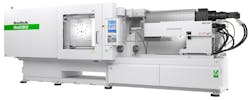Sodick press provides precision for Tier 2 supplier
Problem: A Tier 2 automotive supplier needed an injection molding machine for bigger parts and frequent color changes.
Solution: Team 1 Plastics’ new Sodick press meets its needs for precision and versatility.
By Karen Hanna
Growth. Size. Precision.
A lot of factors played a role in Team 1 Plastics’ decision to take the plunge and invest in a new, 495-ton Sodick press.
One big factor, according to plant manager Dave Sanford, was Sodick’s unique two-plunger injection system.
Compared with traditional injection molding machines (IMMs), it’s “a little more precise,” Sanford said.
“It has a two-stage plunger injection which provides uniform melt conditions, exact material dosing and precision holding stage control,” he said.
A Tier 2 automotive supplier in Albion, Mich., Team 1 manufactures under-the-hood components; it is also working to attract new business from other industries. In the third quarter of 2021, it added the press as the largest in its stable of presses, which at the time consisted of 26 other presses, ranging as small as 27.5 tons.
With a dozen other Sodicks already, the company was comfortable adding the new machine, which provides versatility.
“They’re more durable, there are less maintenance costs, they have more similar parts amongst all of them, so they’re interchangeable to some extent,” Sanford said. “So, instead of having to buy, let’s say, a motor or a pump for a different model, you can buy one and it goes across multiple machines that you could use,” he said.
For operators, the new Sodick has been easy to learn, he said.
Kohei Shinohara is the VP of Plustech, the North American headquarters of Sodick Injection Molding Machinery Division, a joint venture company between Sodick Co. Ltd. and Yamazen Corp. He said the Yokohama, Japan-made presses operate without a traditional check ring.
“Comparing to a traditional, conventional reciprocation-screw system [in which] one screw does everything [and] controls shot size by the check-ring option, our two-stage system [does] not use the reciprocation-screw system. Instead, we separate plasticizing and injection, and shot size [is] being controlled by the positive shut-off mechanism, the screw-touch mechanism,” he said.
This allows greater control over shot size.
“Every time we introduce the same amount of material to the plunger chamber, the exact amount of the shot — we call it the exact dosing system. So, having that separation of the plasticizing and injection, we get the more homogeneous melt, due to the stationary plasticizing. It’s like an extruder,” Shinohara said.
In addition to its precision, the new Sodick press promises a competitive cost of ownership, “because this doesn’t have a conventional screw and barrel,” Sanford said, which would have to be replaced once a year, if not more frequently. Its construction also makes it an easy machine to maintain.
Shinohara pointed out two other advantages of Sodick presses: They are designed for easy color changes and have a small footprint.
Sanford said Team 1 runs 80 to 90 materials, including PC, acrylic, nylon 6/66, PP, PE, ABS, polybutylene terepthalate and TPE.
The company frequently shifts between jobs that require clear plastic and those that require color, Shinohara said.
“Color change for variation is very important for Team 1, and they have found the Sodick has a very easy color change. Material doesn’t hang up in the system, so clear to black, black to clear was very promising, so that they don’t have to do extensive color changes, and they save a lot of time,” he said.
Because they have no check-ring mechanism, Sodick IMMs are “easy to flush out,” he said.
The Sodick press also is compact.
According to Plustech, the 495-ton IMM has a footprint of about 20.5 feet by 5.8 feet; the company said typical, similar-sized machines are around 26 feet by 7.1 feet. The tie-bar distance is about 2.7 feet by 2.7 feet, with about 4.4 feet of daylight.
Team 1 likes Sodicks so much, it is planning to buy another 495-tonner by the end of this year, in anticipation of continued growth in 2023, Sanford said. With bigger machines, the company can do more.
“We’ve been buying more Sodicks over the last, probably 10 years, than we have any of the other two. They’re really excellent molding machines, especially for precision parts that we’re making,” he said.
Karen Hanna, senior staff reporter
Contact:
Plustech Inc., Elk Grove Village, Ill., 847-490-8130, www.plustech-inc.com
About the Author
Karen Hanna
Senior Staff Reporter
Senior Staff Reporter Karen Hanna covers injection molding, molds and tooling, processors, workforce and other topics, and writes features including In Other Words and Problem Solved for Plastics Machinery & Manufacturing, Plastics Recycling and The Journal of Blow Molding. She has more than 15 years of experience in daily and magazine journalism.

